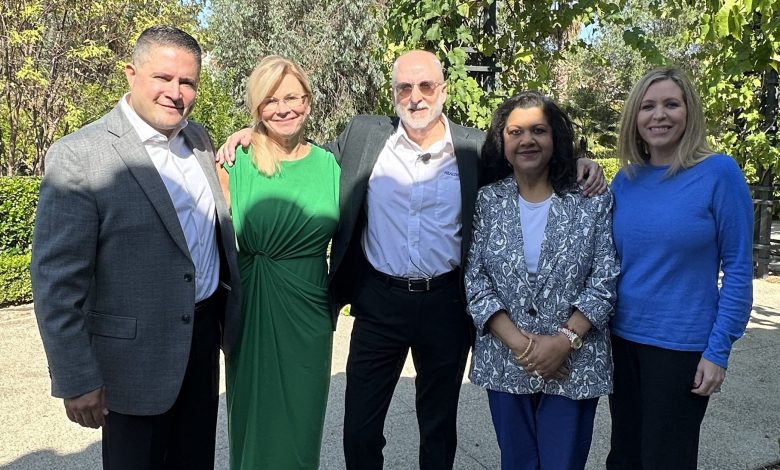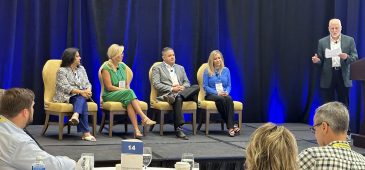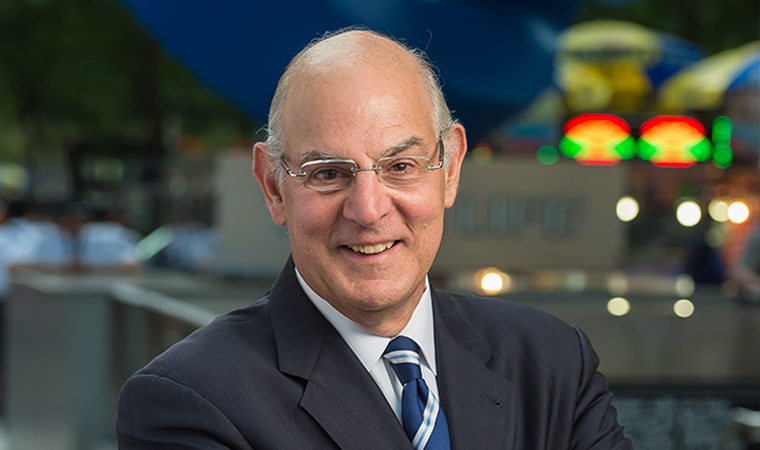
HEALTHTAC West 2024 Panel: Part Two of Staffing Challenges — How We’re Solving Them
By Jim Nelson | August 22, 2024

SAN DIEGO, CA — Together with our sister company, HEALTHTAC, Senior Living News recently held an executive event in this southern California coastal city. Among the many learning and networking opportunities at our event at The Rancho Bernardo Inn were panels that gave attendees a chance to learn some of the best practices our panelists use at their respective companies.
In part one of our articles highlighting the staffing challenges panel, we learned from Traci Taylor-Roberts, the owner and president/CEO at Sodalis Senior Living, how company culture is playing a role in their staffing; Arcadia Communities COO Kristie Kronk shared how the TikTok Ladies impacted hiring and retention at Arcadia; COO Sadek Nassar told us how Calson Management’s preemptive quarterly wage analysis is helping them retain good team members; and from Chandra Kumar, Goodwin Living’s COO, we learned about an initiative they spearheaded that will create new nursing opportunities for up to 50 students in the greater Washington, DC, area.
In part two of our series, I turned to Kristie to have her enlighten the room about Arcadia’s recent adoption of OnShift’s Wallet program.
“Embracing our staff from a pay perspective is important,” Kronk explained. “and many of our staff folks work paycheck to paycheck, sometimes not even making it to the next paycheck. I’m sure everybody has done or is familiar with the A Great Place to Work survey, and Arcadia has done that several years in a row and pay always comes up as an opportunity. We try to be as competitive as we possibly can, and pay for tenure, but one of the things that came out of our survey is, ‘What else can the company do for us outside of pay and benefits?’ What are some of the other softer benefits that would continue to entice folks to want to come to work for Arcadia? So, we went through the opportunity of learning more about what Wallet is, and basically it is sort of a loan on your paycheck. We just rolled this out and within the first two weeks — we have roughly 430 employees across our communities, and 18 people have already taken advantage of [it]. They can take up to 50 percent of their wages earned, or a max of $750, and of the 18, two folks [took] $100 here and $100 there, but the others did a full $750; in one of those cases, they were able to pay for a car that was getting ready to be repossessed. When I think about it, it gives me chills; we all have the luxury of the salaries that we make, but our care staff, the most important people in our world, don’t make the salaries that we make. So, we have to always remember how we can help those individuals because the more we can do as organizations the more loyalty we’ll get from our employees. To hear that in just the short period of time 18 people took advantage of it is heartfelt for me and I hope that it is beneficial for them to be able to pay their electric bill, their rent bill, get a car from not being repossessed. I’m just really excited about what it could do for the future of Arcadia and being able to retain employees.”
At Sodalis they’re using AI and call centers to help cut down on labor costs.
“It’s actually helped us a lot,” Taylor-Roberts replied when asked how that’s working out. “At a lot of conferences I’ve been to they talk about the workforce in the future and how it’s going to be much more challenging than it is even today. So instead of waiting, we rolled out some of those things. I serve a very middle-class market, so rolling out 10 percent increases and 15 percent increases for that group of people is not sustainable year after year; I have to be very thoughtful in how we balance all of this. So, when we took over some independent livings last September, they couldn’t find servers in most of the areas — we couldn’t find anybody for $15.00 an hour because in the restaurant industry, with tips, they can make so much more money. So, we got rid of all the servers and rolled out buffets and that worked really well. And there are robots now. So, we have the same servers in there that can get the drinks and everything for our older clientele, but we rolled out buffets and older people love it because they can get whatever they want. And we’ve also looked at robots for housekeeping, especially in all your common areas and things like that. And call centers in independent living is really where I’m talking about, where you have very high-functioning residents. Call centers that can actually send the leads to the community and we actually have residents that are our salespeople, touring people and getting sales bonuses. Who’s going to sell a community better than an older person? Nobody, ever. And they’re doing all the work for them on the back end, our call center people are, so they’re doing all the notes and all that kind of stuff. And AI is also making notes, emailing people, sending out stuff as well to back them up. In independent living we’ve got a couple of test programs: We partner with TSOLife, where we’ve already got what everybody likes to do in an independent living, so we actually have residents leading our life engagement activities; we’ve replaced some of the life engagement directors and started having residents do it and we pay them instead. That’s actually worked out really, really well.”
The Goodwin Living Foundation endowed the organization with $23 million that they were able to use to fund many different benefits for employees, so I asked Kumar to tell us about some things on that long list of benefits.
“One of them is the citizenship program,” she replied. “We work in a market that has people that are predominantly immigrant workers, so they’re supporting families back home and here. So, this came out of the process of one of our residents and within two weeks the residents raised about $40,000 for this program. It costs about $750 to get the application to be a citizen and if you get a chance look up The Test on Goodwin Living’s site. We also have a playbook on this process; what it’s done is about 150 of our team members have become American citizens. This is really a generational change because now they’re able to bring family members here and have a better life. We have one individual that we shared in that documentary, The Test; he wasn’t able to see his family and his kids for eight years, and his wife was able to come into the United States because he became a citizen and was able to have her come. [The citizenship program is] a partnership with the residents. The residents are tutoring, and if any of you have ever taken the citizenship test — I have — there’s questions on there that the average American that was born and brought up here probably would not remember either. Tuition reimbursement, many of the things that my team members up here talked about, whether it’s a backpack drive, the foundation really does a lot of it. But I’ve worked for organizations that have not, and it’s really a matter of listening to the team members and saying, ‘What is going to make the impact? What do they need?’ I think that we are fortunate to have that foundation.”
For the final question of our panel on staffing challenges I turned to Nassar for some insight into Calson Management’s mentorship program and how it helps retain good team members.
“Basically,” he described, “it ties into what I was mentioning earlier: identifying what’s important to what groups of people you have — your line staff, your directors — and for directors what we found, obviously, is that they would love growth opportunities. ‘Where am I going to go next? What am I going to do with this company? Is there anything more I can do with this company?’ So just identifying some subject matter experts and having a conversation with them and starting to involve them a little bit more with hosting calls for us, inviting them to our executive calls, having them host other calls with their peers, is really starting to go a long way. We’re just career pathing them right now and that’s ultimately what it comes down to: being able to provide them with some more opportunities and have conversations and let them know, ‘We identify you as a future leader with us and we just want to invest back into you.’ And lastly, just involving them in leadership summits like this one, for example, where they get to step outside of their community at least once a year and attend something like this.”




